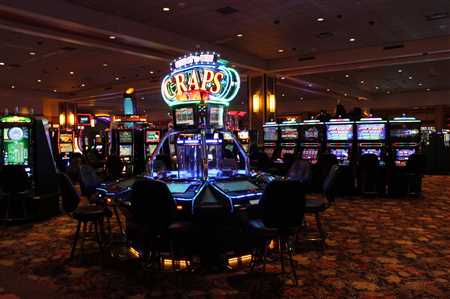

In recent years, a notable transformation has taken place within various entertainment establishments that cater to enthusiasts of chance-based activities. These venues have embraced innovative approaches, providing patrons with exciting opportunities for engagement and interaction. The integration of competitive events has sparked a renewed interest, attracting both casual players and seasoned participants alike.
The rise of interactive experiences has reshaped the landscape of leisure activities in these locales. Visitors find themselves immersed in an environment that fosters camaraderie while indulging in the thrill of challenge and unpredictability. This fresh perspective has paved the way for a vibrant culture centered around skill, strategy, and fortune.
As these establishments continue to evolve, they have become central hubs for community gatherings, bringing together a diverse audience. The combination of entertainment and chance continues to draw individuals seeking both excitement and social connection, solidifying the role of these venues as essential destinations for enjoyable outings.
The evolution of wagering activities within indigenous establishments has gained remarkable momentum in recent years. With the gradual acceptance and expansion of these betting options, numerous venues are witnessing a significant increase in interest and participation from patrons. This surge indicates a shifting dynamic in the landscape of entertainment and leisure, as more individuals engage with various forms of competition-driven staking.
Several elements have played a crucial role in fostering this growth. Enhanced technology, improved infrastructure, and greater accessibility have all contributed to an elevated experience for enthusiasts. Additionally, evolving cultural attitudes towards competitive event engagement have opened doors for more diverse offerings within these establishments, attracting a broader audience. The interplay of these factors has set a foundation for sustainable development and increased patronage.
As operators continue to innovate and respond to consumer demand, the future appears bright for this sector. Anticipation surrounding upcoming events and newly introduced services continues to fuel excitement, suggesting that these venues will remain pivotal in the ever-competitive landscape of recreation. Ongoing partnerships and strategic initiatives may further enhance their appeal, ensuring they stay at the forefront of entertainment offerings.
The journey toward establishing regulated wagering activities in the United States is marked by significant milestones and evolving perspectives. For many years, the landscape was characterized by restrictions and prohibitions, leading to a clandestine environment where enthusiasts participated in informal arrangements. However, as societal views shifted and the economic potential of regulated activities became evident, movements advocating for modification of existing laws gained momentum.
The legalization process has significantly affected various establishments, particularly in regions with a rich history of community engagement and cultural identity. As a result, many facilities have embraced new opportunities, transforming into destinations that not only entertain but also contribute to local economies.
The landscape of gaming has evolved significantly, influenced by changes in regulations and consumer preferences. People are increasingly drawn to interactive experiences that blend skill and chance, creating a dynamic environment for entertainment seekers. The popularity of specific activities has surged, reflecting broader trends and the diverse interests of participants.
Among the favorites, traditional activities continue to hold their ground, while innovative formats are gaining traction. Popular selections include:
As tastes continue to shift, the industry adapts, ensuring that options remain fresh and exciting for all enthusiasts.
The recent surge in regulated recreational gaming activities has brought significant changes to Native American communities. These shifts have created opportunities for economic growth, employment, and infrastructural development, leading to improvements in overall quality of life. As these ventures flourish, they play a crucial role in supporting local economies and enhancing social services for community members.
The establishment of recreational gaming facilities has generated numerous job openings for tribal members and nearby residents. From entry-level positions to management roles, these opportunities contribute to reduced unemployment rates and increased household incomes. Moreover, the training and skills development programs associated with these establishments equip individuals with valuable experience that can be beneficial in various sectors beyond gaming.
The revenue generated from these activities is often reinvested into community projects. This includes funding for education, healthcare, and infrastructure improvements, further uplifting the standard of living for tribal members. Enhanced public services foster a sense of community well-being and ensure that essential needs are met, paving the way for sustainable growth and resilience.
The establishment under discussion has become a benchmark for achievement within the entertainment and wagering landscape. With a diverse range of offerings, it engages a wide audience and ensures a steady flow of visitors through its doors. This success can be attributed to innovative strategies that harmonize traditional practices with modern trends, setting a standard for similar venues.
One of the primary factors contributing to its prosperity is the implementation of cutting-edge technologies and customer-focused services. By embracing digital advancements, the venue creates an immersive experience, allowing patrons to interact seamlessly with their environment. This commitment to modernization enhances overall satisfaction and fosters loyalty among guests.
Moreover, the establishment places significant emphasis on community connections. Through partnerships and local initiatives, it enhances its reputation while generating positive economic impacts. By supporting local events and charities, it cultivates a sense of belonging and ensures that its growth translates into benefits for the surrounding area.
In conclusion, the blend of modern innovation and community outreach positions this venue as a prominent leader in its field. Its model can serve as an inspiration for others looking to replicate its success in the competitive landscape of entertainment and leisure activities.
The establishments in focus are renowned for their distinctive attributes and diverse range of alternatives that cater to a wide audience. From exciting experiences to engaging amenities, they create an inviting atmosphere for visitors seeking entertainment and leisure.
The variety of gaming experiences available is truly remarkable. Patrons can enjoy a plethora of activities, including:
Beyond gaming, these venues offer a rich collection of entertainment and amenities designed to enhance the overall experience:
These unique features combine to create a vibrant environment that appeals to various guests, ensuring a memorable visit for all who enter.
The importance of client satisfaction in the realm of entertainment venues cannot be overstated. Establishing a welcoming atmosphere, along with high-quality service, plays a crucial role in ensuring that visitors have memorable experiences. Gathering opinions from patrons not only helps in understanding their needs but also aids in enhancing the offerings available at these recreational establishments.
Feedback from attendees often highlights the variety of options available, the ambiance of the location, and the professionalism of the staff. Positive experiences lead to repeat visits and cultivate a loyal clientele. Many guests appreciate the dedication to creating an engaging environment, with activities that cater to diverse interests.
Moreover, accessible channels for sharing experiences are now more crucial than ever. Many patrons opt to leave reviews online, providing valuable insights into their visits. This feedback loop is vital for management to identify areas for improvement and to celebrate their successes. By prioritizing customer experiences, these venues not only retain existing patrons but also attract new visitors eager for a thrilling experience.
The surge in earnings within the realm of regulated competition has sparked significant interest among various establishments. This upward trajectory in financial performance underscores the robust appeal of this entertainment sector, fostering initiatives that aim to enhance customer experiences and expand operational capacity. Stakeholders are keenly observing patterns in consumer engagement, with an emphasis on innovative approaches to retain patron interest and drive additional revenue streams.
Plans are underway to introduce new amenities and diversify offerings, aiming to cater to a broader audience. By integrating advanced technology and unique experiences, establishments are positioned to capture a larger market share. Partnerships with local businesses and community initiatives are also anticipated to play a crucial role in fostering growth and enhancing brand loyalty.
Looking ahead, a strategic focus on sustainability and responsible engagement will shape future initiatives. Emphasizing community involvement and economic development, these endeavors not only aim to boost profitability but also to establish a positive social impact. With a commitment to innovation and customer-centric solutions, the industry is poised for continued success and expansion in coming years.
The landscape of gaming establishments in the state reflects a diverse array of experiences and operational frameworks. Each type offers unique advantages, resulting in varying atmospheres, regulatory environments, and community impacts. Understanding the distinctions between these venues provides insight into their roles within the local economy and culture.
Ownership and Regulation play crucial roles in shaping the operations of these gaming entities. The first category is often affiliated with Native American nations, enjoying a degree of sovereignty that allows for self-governance and specific regulatory structures. In contrast, the latter is typically operated by private enterprises, subject to state regulations and requirements, which can influence everything from marketing strategies to financial obligations.
Additionally, Revenue Distribution marks a significant differentiator. Establishments linked to indigenous communities frequently allocate funds directly to tribal welfare and initiatives, impacting health, education, and infrastructure in their regions. Conversely, commercial venues generally funnel revenues into state coffers, aimed at broader public services and projects, potentially impacting service levels across the state.
The customer experience also presents notable differences. Venues associated with Native American tribes often emphasize cultural elements, integrating aspects of tradition and heritage into their design and services, which can foster a unique sense of place. On the other hand, privately owned establishments might focus on a mainstream entertainment approach, offering a more standardized experience but possibly lacking the cultural connection found in their tribal counterparts.
Overall, an exploration of these two types of venues reveals a complex interplay of social, economic, and cultural factors, each contributing distinctly to the rich tapestry of leisure options available in the region.